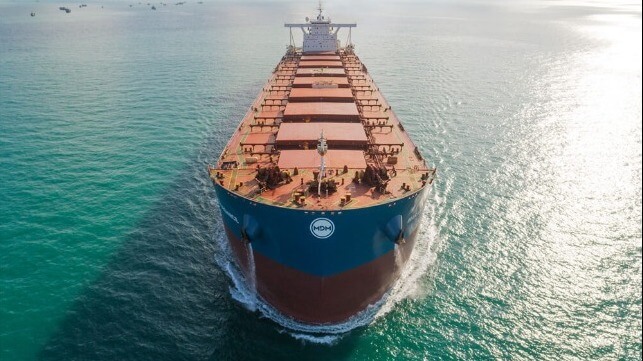Project Plans LNG-Fueled Bulker That Produces Hydrogen for Power

Efforts are beginning to experience with different forms of hydrogen as a power source for vessels including early tests aboard cruise ships and offshore supply vessels and joining the process will be a newcastlemax bulk carrier that can produce hydrogen aboard extracting it from LNG. The project is based on a technology already under development and which has gained initial approval from the Italian class society RINA.
Greece’s Maran Dry Management, part of the Angelicoussis Group, has signed a Joint Development Project agreement with RINA and Chinese designer SDARI for a new bulk carrier. The 210,000 dwt bulker will use the innovative technology for a LNG-fueled vessel that can produce hydrogen in a process that uses existing LNG infrastructure and requires no hydrogen on shore.
“Working with RINA and SDARI, this JDP agreement will give us a highly competitive bulk carrier design that will exceed IMO’s current 2050 targets and ultimately get to near-zero emissions,” said Captain Babis Kouvakas, Managing Director at Maran Dry Management. He called the process a pioneering concept that can provide an example to exceed the current and projected emissions reduction targets. “The design will allow us to run the vessel on increasing percentages of hydrogen, lowering emissions over time, to meet the increasingly stringent rating thresholds towards 2050.”
The project will be based on a propulsion arrangement which reduces the running machinery at sea and combines the ship’s fuel (LNG) with steam to produce hydrogen and CO2. The project sees the design, which was launched earlier this year for an MR tanker, in its first application for a bulk carrier.
The design is based on a pre-combustion carbon capture principle. The CO2 is captured by splitting the LNG molecules before the combustion in the engine takes place, rather than from exhaust gas emissions. The engineers explained that this involves lower mass flows, therefore a reduced space required, and scalable installation to progressively keep up with the pace of the emissions reduction requirements up to 2050. The vessel can be built as an ordinary dual fuel ship, and the extra equipment installed once regulations incentivize the investment.
“The concept was conceived to be used on a wide range of vessel sizes,” explains Paolo Moretti, CEO at RINA Services. “We have already approved its feasibility on a MR tanker, This joint development project will show how a Newcastlemax bulk carrier design can benefit from the LNG and hydrogen solution.”
One of the key advantages of this approach is that it can leverage existing LNG bunkering facilities and requires no onshore hydrogen infrastructure and no need for supply and storage of hydrogen on board. It will also aim to reduce the resistance of the ship to increase overall operational efficiency.

that matters most
Get the latest maritime news delivered to your inbox daily.
In a similar demonstration project, MSC Cruises’ newly completed MSC World Europa has a trial hydrogen installation. Also using LNG as its primary fuel source, the cruise ship has a system, based on technology from Bloom Energy. It is a Solid Oxide Fuel Cell (SOFC) that is made up of two 75kW modules. The fuel cells using LNG produce electricity generated by the electrochemical reactions.
Another hydrogen technology this is being developed is based on Proton Exchange Membrane (PEM) fuel cells. It works with conventional fueled vessels but requires hydrogen tanks aboard. Last week, Fincantieri delivered the cruise ship Viking Neptune with the first PEM demonstration system. The experimental hydrogen fuel cell module provides a nominal power of 100 kW, but the shipbuilder is working with Viking Cruises and says the second step will be the development of a hydrogen generation system with a total power of approximately six to seven MW.
